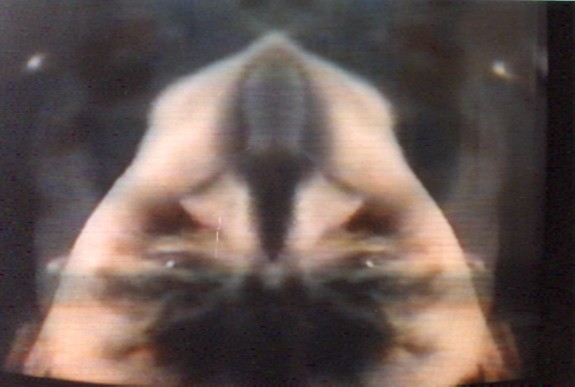<< zurück
 |
Jeremy Welsh
GB 1990, 7:30
EMAF 1990
Tour:
1990/1991
im Verleih: ja / in distribution: yes
distribution@emaf.de // Tel: 00 49 / (0)541 / 2 16 58
Credits:
U-matic, 7:30, col., Großbritannien März 1990. Regie und Editing: Jeremy Welsh. Kamera: Jacqueline Welsh. Ton: Tom Meyer.
Beschreibung:
Da wir in einer Gesellschaft leben, für die Das Bild als primäre linguistische Form und als herrschendes Äquivalent funktioniert, besitzt der Mythos des Narziß eine besondere Bedeutung und eine zusätzliche Ebene der Eindringlichkeit für die zeitgenössische Menschheit. Wir starren unser Spiegelbild nicht mehr länger mit hoffnungsloser Sehnsucht an, jedoch starren wir darauf als nahezu buchstäbliche Erweiterung unseres Selbst, als Alternative zu uns selbst, als metophorisches Gewand, in das wir unsere innere Identität kleiden. Der zurückgestoßene Liebhaber, Echo, ist nicht länger ein unglücklicher Geist: statt dessen repräsentiert sie/er eine Sublimierung von Wünschen in die dimensionslose und kontaktlose Gemeinschaft der Bilder. Im Post-AIDS Zusammenhang wird Bilderkonsum als Sexualakt zum lebensfähigen Konzept und als solches wird die Unmöglichkeit der sexuellen Vereinigung mit sich selbst beseitigt.
Für den zeitgenössischen Narziß ist das reflektierende Becken eine technologische Form oder ein Komplex von Formen, die nicht nur das Versprechen der perfekten Reflexion anbietet, sondern auch das Versprechen eines Bildes, das perfekter als sein Original ist, und noch dazu ein Bild, das unendlich kopiert und auf Wechselwirkung programmiert werden kann.
WATERBOY betrachtet diese Fragen mittels einer neuen Inszenierung des Drehbuches vom Mythos des Narziß als eine klare künstliche Konstruktion in der die Unvollkommenheit eines nicht mehr Jugendlichen klar gesehen wird und durch die in dem Werk benutzten Qualitäten von Licht und Bild sogar noch übertrieben werden.
Letztendlich ist es gleichzeitig eine Rückkehr zu ewigen Themen, daß man sich selbst verlieren kann in Reflexionen, im Wasser, in eigenen fixen Ideen und in der Suggestion, daß Bilder wie Wasser verborgene Tiefen und Geheimnisse verbergen können, wir für eine Konfrontation mit ihnen aber noch nicht bereit sind.
Description:
For contemporary humanity, the myth of Narcissus has a particular significance and an added level of poignancy as we live in a society for which The Image has come to function as a primary linguistic form and as a dominant token of exchange. No longer do we stare at our reflections with hipeless longing, however, we stare at them as almost literal extensions of ourselves, as alternatives to ourselves, as metaphorical garments in which we clothe our inner identities. The rejected lover, Echo, is no longer a hapless phantom: instead S/He comes to represent a sublimation of desire into the dimensionless and contactless communion of images. In the post AIDS context, image consumption as sexual act becomes a viable concept, and as such, the impossibility of sexual union with the self is removed.
For the contemporary Narcissus, the reflecting pool is a technological form, or complex of forms, that offers not only the promise of The Perfect Reflection, but even the promise of an image more perfect than its object, and moreover, an image that can be endlessly replicated and programmed to interact.
WATERBOY considers these questions by means of restaging the scenario of the Narcissus myth as a clearly artificial construct, and one in which the imperfections of one no longer a youth are seen clearly and are even exxaggerated by the qualities of lieght and image used in the work.
Finally it is both a return to eternal themes, that one can lose oneself in reflection, in water, in self obsession, and a suggestion that Images, like Water, may conceal hidden depths and mysteries that we are not yet ready to confront.
<< zurück